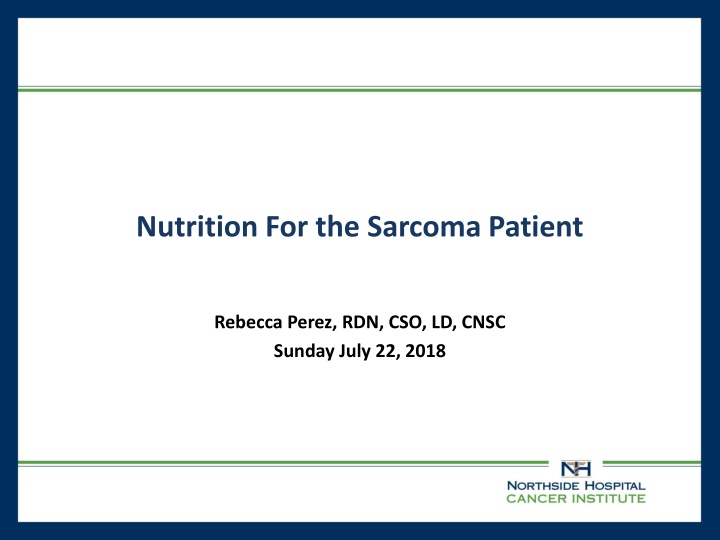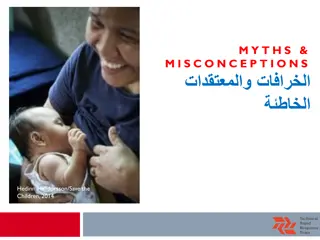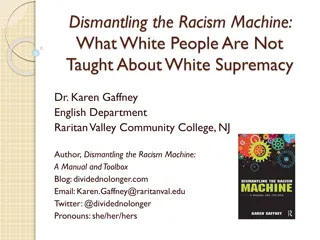Nutritional Guidelines for Sarcoma Patients: Debunking Myths, Addressing Challenges
Explore debunked cancer food myths such as the impact of sugar, alkaline environments, herbal supplements, and artificial sweeteners. Learn strategies for coping with common nutrition challenges during treatment, including nausea, decreased appetite, altered taste, diarrhea, and constipation. Discover tips on maintaining a balanced diet with small meals, proper hydration, and managing taste alterations. Enhance your understanding of plant-based eating plans for optimal health.
Download Presentation

Please find below an Image/Link to download the presentation.
The content on the website is provided AS IS for your information and personal use only. It may not be sold, licensed, or shared on other websites without obtaining consent from the author.If you encounter any issues during the download, it is possible that the publisher has removed the file from their server.
You are allowed to download the files provided on this website for personal or commercial use, subject to the condition that they are used lawfully. All files are the property of their respective owners.
The content on the website is provided AS IS for your information and personal use only. It may not be sold, licensed, or shared on other websites without obtaining consent from the author.
E N D
Presentation Transcript
Nutrition For the Sarcoma Patient Rebecca Perez, RDN, CSO, LD, CNSC Sunday July 22, 2018
Objectives Review some common cancer food myths Review tips for the 5 most common nutrition challenges during treatment Review the plant based eating plan
Debunking the Cancer Food Myths The Myth: Sugar Feeds Cancer The Myth: Cancer Cells Cannot Survive in an Alkaline Environment The Myth: Herbal Supplements Help Fight Cancer The Myth: Artificial Sweeteners Cause Cancer
5 Most Common Nutrition Challenges During Treatment Tips for Coping with Nausea/Vomiting Tips for Coping with Decreased Appetite/Early Satiety Tips for Coping with Altered Taste Tips for Coping with Diarrhea Tips for Coping with Constipation
Tips for Coping with Nausea/Vomiting Take you anti-nausea medications as instructed! Eat 5 - 6 small meals a day instead of three large meals. Drink clear liquids as often as possible after vomiting to prevent dehydration Freshen your mouth with a homemade mouth rinse of 1 teaspoon of baking soda, 1 teaspoon of salt, in a quart of water. Swish and spit. Eat bland foods, instead of foods that are very sweet, fatty, greasy, or spicy. Eat dry foods (such as crackers, toast, dry cereal, or bread sticks) when you wake up and every few hours during the day when you are taking medications or when you feel nauseated.
Tips for Coping with Decreased Appetite/Early Satiety Eat 5 or 6 small meals instead of 3 large meals. Eat by the clock. Try to eat something every 2-3 hours. Keep your pantry and freezer well stocked with foods that make quick and easy meals and snacks, tuna fish, sardines, peanut butter, soups, crackers, cheese, cottage cheese, hard boiled eggs. Eat a bedtime snack. This will give you extra calories without affecting your appetite at your next meal. Make every bite count by choosing protein rich foods. Drink liquids throughout the day even when you do not feel like eating. Choose liquids that add calories and other nutrients. Drink only a small amount of liquids when you are eating meals. Many people feel too full if they eat and drink at the same time
Tips For Coping with Altered Taste Choose foods with tart flavors, such as lemon wedges, lemonade, citrus fruits, vinegar, and pickled foods. (Caution: avoid these acidic foods if you have a sore mouth or throat.) Marinate foods in a balsamic vinaigrette salad dressing. Season foods with herbs, spices, and other seasonings, such as onion, garlic, chili powder, basil, oregano, rosemary, tarragon, barbecue sauce, mustard, ketchup, or mint. Try Mrs. Dash seasonings. Eat frozen fruits, such as whole grapes and mandarin orange slices, or chopped cantaloupe or watermelon. Before eating, rinse your mouth with the homemade mouth rinse, 1 teaspoon salt, and 1 teaspoon baking soda in a quart of water. Rinse and spit. If you have a metallic taste, try using plastic flatware and glass cups. Avoid canned vegetables, fruits and soups.
Tips for Coping with Diarrhea Avoid high fat and spicy foods Choose low fiber, bland foods Sip on broth, tomato juice, V-8 and electrolyte replacement drinks to help replenish electrolytes Add foods with soluble fiber to help thicken stool (banana, applesauce, oats, white rice, white pasta) Limit lactose, sugar and sorbitol Limit hot, caffeinated beverages Watch for medications containing magnesium
Tips for Coping with Constipation Eat at about the same times each day Drink plenty of liquids (at least 8 cups daily) For variety, drink water, prune juice, warm fruit or vegetable juices, decaffeinated teas, or hot water with added lemon juice and honey. Fluids also include foods that are liquid at room temperature, like frozen ice pops, gelatin, or ice cream. Eat foods high in fiber Work up to 25-38 grams of fiber a day. Be sure to increase fiber slowly. Increase the amount of fiber you eat by no more than 5 grams each day.
Eating Well Using a Plant Based Eating Plan Recommended by the American Cancer Society (ACS) and the American Institute for Cancer Research (AICR). Plant based eating provides antioxidants and phytonutrients/phytochemicals that help fight cancer cells and scavenge free radicals in the body. Plant based eating helps reduce inflammation throughout the body.
Phytonutrients/Phytochemicals They provide plants with color, odor and flavor. Not one single food has all the phytonutrients in it. Research has shown that phytonutrients work better together so variety is the message.
Eat By Color To Include a Variety of Phytonutrients/Phytochemicals Red: tomatoes, bell peppers, cranberries, cherries, raspberries, onions, apples Orange: carrots, pumpkin, sweet potato, turmeric Yellow: ginger, pineapple, summer squash, pear, apple Green: broccoli, kale, green tea, spinach, Brussel sprouts Purple: blueberries, figs, grapes, blackberries, eggplant Tan/White: coffee, garlic, mushrooms, nuts, onions, seeds, soy, tea, whole grains
Vegetables Aim for 4 or more servings per day. (1cup raw leafy, cup cooked/raw for all others) When cooking vegetables, they should be slightly cooked. Steam, bake, stir-fry, roast, or lightly saut or raw. (No deep fried) Drizzle 1tsp. Olive oil on vegetables for greater phytonutrient absorption!
Fruits Aim for 2 3 servings per day. (1 medium or cup cut up raw or canned, approx. 12 grapes) Choose fresh when in season or canned in their own juice or frozen with no added sugar. Avoid drinking ALL fruit juices!
Whole Grains Aim for 3 servings per day. Brown and Wild Rice Oatmeal Quinoa Barley 100% whole wheat bread/English muffin Whole grain cereal Whole wheat pasta Corn Tortillas Corn, sweet potato, pumpkin, winter squash (acorn, butternut) these are considered grains on your plate not vegetables.
Lean Protein Choices Dried Beans, Peas & Lentils: 3 4 servings per week Fish: 3 4 servings per week (not fried) Chicken and Turkey breast meat no skin Veggie Burgers Eggs no more than 3 or 4 yolks per week Tofu Tempeh Soybeans/Edamame
Dairy & Dairy Alternatives Aim for 2 3 servings per day. Skim or 1% milk Non Fat Greek Yogurt Low Fat Cottage Cheese 2% or Low Fat Cheese Skim Soy Milk Skim Lactaid Almond Milk, Oat Milk, Rice Milk needs to be fortified with calcium and does not contain significant amounts of protein.
Healthy Fats 1 2 servings per day. Nuts and Nut Butters (Peanut Butter, Almond Butter, Cashew Butter) Seeds: Flaxseed, Pumpkin Seed, Sesame Seed, Sunflower Seeds, Chia Seeds Oils: Canola oil, Olive oil, Peanut oil, Flaxseed oil, Grape Seed oil, Safflower oil, Sesame oil, Sunflower oil Avocados Olives
Where to Find More Information American Cancer Society: cancer.org 1-800-227-2345 American Institute of Cancer Research (AICR) aicr.org: 1-800- 843-8114 Books: American Cancer Society Complete Guide to Nutrition for Cancer Survivors: Eating Well, Staying Well During and After Cancer, 2ndEdition What to Eat During Cancer Treatment American Cancer Society s Eating Healthy Cookbook, 3rd Edition























